- Home
- Cassandra Clare
Shadowhunters and Downworlders Page 4
Shadowhunters and Downworlders Read online
Page 4
Page 4
Art is a part of Clary, just like her Shadowhunter lineage—but unlike her Shadowhunter side, art is something she understands. She uses it to makes sense of the world, to clear her mind and solve problems. And just as she can relax her mind and imagine turpentine clearing away a glamour, she can open her mind to inspiration when she or her friends are in trouble. She’s used to images appearing in her head—and she’s used to taking those visions and letting them flow from her pencil to the page.
So when she starts envisioning new runes, she picks up a stele and does what comes naturally.
“Where do you get your ideas?” is a question every artist is asked, and there is never just one answer. Ideas come in dreams or visions; they can come from conscious thought or seem to take shape on their own. The concept of the muse exists because there is no one way of explaining how and why artists are inspired to create—and why, other times, their creativity seems to desert them. When in City of Glass Simon asks Clary where her runes come from, she says:
“I don’t know…All the runes the Shadowhunters know come from the Gray Book. That’s why they can only be put on Nephilim; that’s what they’re for. But there are other, older runes…So when I think of these runes, like the Fearless rune, I don’t know if it’s something I’m inventing, or something I’m remembering…”
Sometimes new runes come to Clary fully formed, in a sudden burst of inspiration. The first hint we get of her rune-creating ability happens like this. When she and Jace are trapped on the roof of the Dumont (aka Dumort) Hotel, seconds away from being caught by the werewolves and vampires that are chasing them, they need to find a way off the roof, and Clary envisions a rune shaped like wings. Jace commandeers one of the vampires’ flying motorcycles before Clary has a chance to test that rune, but we—the readers—are pretty sure it was a Flight rune, and it’s a tantalizing promise of things to come.
Some new runes take shape only as Clary draws them, as if instinct and need are guiding her hand—like when Jace is imprisoned in the Silent City, and Clary’s so frantic to get him out that the simple Open rune she thinks she’s writing knocks the door right off its hinges and unlocks every pair of manacles in the vicinity.
Other runes require Clary to focus on the essence of the rune she wants to create, as when she’s desperate to follow Jace, Simon, and the Lightwoods to Idris, but the portal has closed and Magnus refuses to open another one. Clary grabs her stele, closes her eyes, and imagines “lines that spoke to her of doorways, of being carried on whirling air, of travel and faraway places” (City of Glass) until the Portal rune comes together in her mind, and she is able to draw it and open a portal to Idris herself.
Still other runes come to Clary in visions from the angel Ithuriel, such as the Alliance rune she uses to join Shadowhunters and Downworlders together in combat. I like to think the angel acts as her muse in those instances. Clary and Ithuriel are connected by blood, and that connection is part of what makes her runes so powerful, but it is Clary’s artistic sensibility that allows her to take what she sees in those visions and make it real.
As impressive as Clary’s new and amplified runes are, her power goes beyond the individual runes she creates. It’s her ability as an artist to see possibility where others see a blank page and, by extension, to see victory where others see certain defeat that truly empowers her and allows her to challenge Valentine when the Clave is on the verge of giving up.
The Master Plan versus the Masterpiece
An artist is used to failure. Not every work she envisions is going to come out right the first time. There will be disappointment and torn-up sketches—but a dedicated artist knows to keep going until she gets it right. Sometimes it’s a matter of rethinking the original concept. Sometimes the flaw is in the execution. But no matter why it’s not working, an artist knows that the struggle isn’t over until she chooses to abandon the piece. She has to be flexible and keep her mind open to inspiration—but she will succeed. Because she’s learning, and getting better, every day.
Valentine, Clary’s father and the villain whose search for the Mortal Instruments sets the Mortal War in motion, is not an artist. He’s a Shadowhunter warrior who believes in physical strength above all else, a narrow-minded megalomaniac and a first-class manipulator who lets his “son” Jace take a bath in spaghetti on his birthday but also breaks the neck of Jace’s pet falcon, just to teach Jace the lesson that “to love is to destroy”…which I guess means that Valentine really, really loves the Clave, his family, and Downworlders, because he wants to destroy all of that and rebuild it to suit his “pure” sensibilities. This is the guy who, when his best friend, Lucian, got turned into a werewolf, offered him a knife and told him to do the right thing and kill himself. We can see how far the Clary apple falls from the Valentine tree just by how they treat their BFFs, both of whom became Downworlders, interestingly enough.
Like most villains, Valentine has a master plan. And because his enemies believed he was dead for over sixteen years, he’s had more than enough time to perfect it. He has spies on his side; he’s bolstered himself with demon and angel blood; he even has a part-demonic secret son to unleash. He can predict the Clave’s every move and counter it. By the time he makes his play for the Mortal Cup, he’s confident no one can stand in his way.
Valentine knows he has to gather the Mortal Instruments in order to gain the power to bring the Clave to its knees and make his dream of a “pure” world a reality: first the Mortal Cup, then the Mortal Sword, then the Mortal Mirror. When he has all three Mortal Instruments, he can summon the angel Raziel and compel him to cleanse the world of “corrupt” Shadowhunters and Downworlders (“corrupt” meaning anyone who’s not on Valentine’s side).
Valentine has planned for every contingency he can imagine, but he has a weakness: His imagination only stretches so far. He’s two steps ahead of everyone…except Clary.
Clary’s a dreamer. For years, she’s faced the blank page and filled it with figures from her fantasies or careful depictions of things she’s seen. As an artist, her imagination isn’t fettered by the constraints of reality.
Valentine is playing by a specific set of rules—he expects to win because he has what he believes is a road map to victory. Clary, a creative thinker, is unpredictable—she doesn’t play by Valentine’s rules, she makes her own. And she uses her imagination—her ability to think outside the Gray Book—to stop Valentine at every turn.
When Jace asks Clary if she can create a Fearless rune, she focuses, goes into that artistic zone that even Simon can’t pull her out of, and draws a rune no one has seen before. It’s Clary’s Fearless rune that enables Jace to withstand the Greater Demon Agramon’s fear attack when Valentine unleashes him in City of Ashes. Valentine used Agramon to murder a Silent City’s worth of Silent Brothers, but Jace can’t be undone by his worst fear, thanks to the strength Clary has drawn onto his skin.
When Valentine’s demon army is busy making short work of the Shadowhunters on board Valentine’s Ship of Evil (note: not its actual name), Clary is the one who demolishes her father’s plans by dismantling the entire ship with her superpowered Rune of Opening. Nuts, bolts, walls, floors, everything falls apart—as does Valentine’s victory. Clary can’t beat him in combat, so she ends the battle by destroying his battleground instead.
And when the Clave is about to surrender to Valentine’s demands, because they’re certain they can’t win against “every demon the Mortal Sword can summon” (City of Glass), Clary is the one who insists that the fight isn’t over yet. She brings the Shadowhunters and Downworlders together by creating a rune that even Downworlders can wear: an Alliance rune that allows pairs of Shadowhunters and Downworlders to fight together and to draw on each other’s strengths. And, by insisting they team up—“if you don’t fight beside them, the runes won’t work” (City of Glass)— Clary is creating not just a temporary magical alliance but, potentially, a lasting one. She’s helping to brea
k down the walls of misunderstanding and fear that have kept the Shadowhunters and Downworlders from being true allies.
The bonding of Shadowhunters and Downworlders is a development that Valentine never could have foreseen— because, aside from it being unlikely, prior to Clary’s Alliance rune, it simply wasn’t possible. And the Alliance rune is an especially apt way to challenge Valentine, because he has been bitterly jealous of the Downworlders’ powers for years. He went so far as to imprison Downworlder “specimens” in an underground lab, where he experimented on and tortured them in an attempt to learn their secrets. When Valentine similarly imprisoned the angel Ithuriel, initially it was to get answers to these questions: “Why should their powers be greater than ours? Why can’t we share in what they have?” (City of Glass)
Valentine hated that Downworlders possessed powers Shadowhunters lacked, but it never occurred to him to try to share the Downworlders’ powers peacefully, in a way that would benefit both groups. His selfishness and cruelty blinded him to that possibility, whereas Clary’s open mind allowed her to accomplish what her father never could.
In the end, when all seems lost—when Valentine stands at the edge of Lake Lyn with the Mortal Cup and Mortal Sword in hand; Jace lies dead on the ground; and Clary is devastated and hindered by runes that prevent her from speaking, separating her bound wrists, or walking—she grips a stele in her bound hands and, with a few swipes, draws over one of the runes Valentine has written to contain and control the angel Raziel. It is the rune symbolizing Valentine’s name, and Clary uses the last of her strength to write her own name over it.
That single small rune is all she can manage, but it is enough. It makes her the master of the circle Valentine has drawn, which allows her to compel Raziel—while also stripping that power from Valentine, who picked the wrong day to incite an angel’s holy wrath.
Clary has fought by using her art and imagination every step of the way. It’s as if this battle against Valentine is her masterpiece, and she’s signing her name to all of it. Her signature: the final mark you put on a piece of art—because she’s given it all she has, and it’s done. This fight with Valentine—it’s over.
With one final Mark, Clary signs her name to her father’s defeat and puts an end to his reign of terror.
She Came, She Drew, She Conquered
It’s fitting that during the final confrontation with Valentine in City of Glass, Clary is unable to speak. Valentine has silenced her with a rune, so her last words to him—when he’s finally seen her for who she is, instead of the weak little girl he perceives her to be—are not spoken but drawn.
Clary stretched out her hand, and with her finger she wrote in the sand at his feet. She didn’t draw runes. She drew words: the words he had said to her the first time he’d seen what she could do, when she’d drawn the rune that had destroyed his ship.
mene mene tekel upharsin.
Valentine has known about Clary’s rune-creating ability, but until defeat is staring him in the face, he still thinks of her as weak. He underestimates her time and time again— because she was raised as a mundane, not a Shadowhunter. Because she’s an artist, not a warrior. He refuses to give her the respect she deserves, despite the fact that she has thwarted him multiple times, because he can’t acknowledge that the way she fights back is fighting.
But a fighter is not just someone who dispatches enemies with a blade or a bow. A fighter is someone who fights— with everything and anything she has at her disposal.
Clary is an artist, and before she draws her first rune, she has never used her art as a weapon. But once she is faced with a war that must be won—a war that endangers the people she loves—she becomes an artist who fights. She won’t leave this war to be won by others. She can’t do it alone—but the war can’t be won without her either.
The seemingly mundane, pre-Shadowhunters Clary who took art classes at Tisch, and drew fantasy warriors in her sketchbook, and sighed over cartoon princes probably didn’t think of herself as a hero. But I’d bet that in her daydreams, when she was busy drawing heroes or disappearing into a fantasy world, she felt like she could be one. Like there was heroic potential in her, just waiting to be tapped.
How many of us read fantasy because we have that same feeling? We live vicariously through stories, because our own lives provide so few opportunities for high-stakes adventure and noble sacrifice. And most of the time, even as we wish we could be like our favorite heroes, we know that we’re just too different. Jace has killed more demons than any other Shadowhunter his age. Isabelle handles her electrum whip with such finesse, it’s as if the weapon is a part of her. Alec’s skill with a bow and arrow allows him to make shot after shot, even in a high-stress battle situation. Maia’s werewolf nature means that she’s faster and more ferocious than any human could hope to be.
Clary, though…Clary is like you, or me, or that kid in class who’s always drawing instead of taking notes. We know this girl. And that’s part of what makes Clary such an amazing heroine. Because she manages to do extraordinary things using talents she honed during a mostly ordinary life.
Clary is what I think a lot of us hope we could be, if we found ourselves in her situation: someone who becomes a hero out of necessity, who is not on an even playing field with the rest of the players—but who, out of sheer determination, finds a way to turn her natural talents into the tools of her survival.
Clary saves lives—her own, and those of her friends. She draws a better world into existence, and she never lets the word impossible stop her.

 The Midnight Heir
The Midnight Heir Son of the Dawn
Son of the Dawn Angels Twice Descending
Angels Twice Descending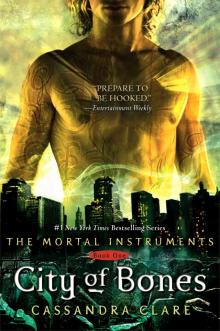 City of Bones
City of Bones Vampires, Scones, and Edmund Herondale
Vampires, Scones, and Edmund Herondale Bitter of Tongue
Bitter of Tongue What Really Happened in Peru
What Really Happened in Peru Shadowhunters and Downworlders
Shadowhunters and Downworlders Learn About Loss
Learn About Loss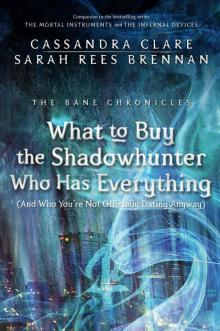 What to Buy the Shadowhunter Who Has Everything
What to Buy the Shadowhunter Who Has Everything Welcome to Shadowhunter Academy
Welcome to Shadowhunter Academy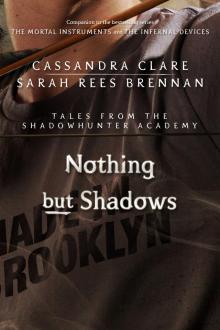 Nothing but Shadows
Nothing but Shadows Clockwork Prince
Clockwork Prince The Fiery Trial
The Fiery Trial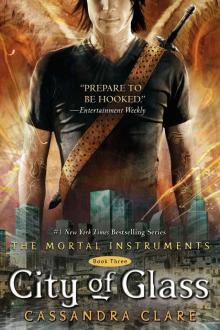 City of Glass
City of Glass Clockwork Angel
Clockwork Angel City of Heavenly Fire
City of Heavenly Fire The Rise of the Hotel Dumort
The Rise of the Hotel Dumort The Shadowhunters Codex
The Shadowhunters Codex Cast Long Shadows
Cast Long Shadows City of Lost Souls
City of Lost Souls Lady Midnight
Lady Midnight Lord of Shadows
Lord of Shadows The Whitechapel Fiend
The Whitechapel Fiend City of Fallen Angels
City of Fallen Angels Clockwork Princess
Clockwork Princess Queen of Air and Darkness
Queen of Air and Darkness Saving Raphael Santiago
Saving Raphael Santiago The Red Scrolls of Magic
The Red Scrolls of Magic City of Ashes
City of Ashes Pale Kings and Princes
Pale Kings and Princes The Runaway Queen
The Runaway Queen The Last Stand of the New York Institute
The Last Stand of the New York Institute A Long Conversation (The Shadowhunter Chronicles)
A Long Conversation (The Shadowhunter Chronicles) The Lost Book of the White
The Lost Book of the White Chain of Gold
Chain of Gold The Fall of the Hotel Dumort
The Fall of the Hotel Dumort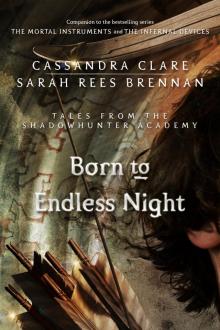 Born to Endless Night
Born to Endless Night The Lost Herondale
The Lost Herondale An Illustrated History of Notable Shadowhunters & Denizens of Downworld
An Illustrated History of Notable Shadowhunters & Denizens of Downworld Ghosts of the Shadow Market
Ghosts of the Shadow Market Through Blood, Through Fire
Through Blood, Through Fire Every Exquisite Thing
Every Exquisite Thing City of Fallen Angels mi-4
City of Fallen Angels mi-4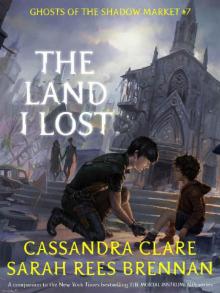 The Land I Lost (Ghosts of the Shadow Market Book 7)
The Land I Lost (Ghosts of the Shadow Market Book 7) Queen of Air and Darkness (The Dark Artifices #3)
Queen of Air and Darkness (The Dark Artifices #3) The Wicked Ones (Ghosts of the Shadow Market Book 6)
The Wicked Ones (Ghosts of the Shadow Market Book 6) The Wicked Ones
The Wicked Ones A Deeper Love
A Deeper Love City of Fallen Angels (4)
City of Fallen Angels (4) The Evil We Love (Tales from the Shadowhunter Academy Book 5)
The Evil We Love (Tales from the Shadowhunter Academy Book 5) Vampires, Scones, and Edmund Herondale tbc-3
Vampires, Scones, and Edmund Herondale tbc-3 City of Glass mi-3
City of Glass mi-3 Tales from the Shadowhunter Academy
Tales from the Shadowhunter Academy The Infernal Devices Series
The Infernal Devices Series City of Ashes mi-2
City of Ashes mi-2 Cassandra Clare: The Mortal Instruments Series
Cassandra Clare: The Mortal Instruments Series The Bane Chronicles 7: The Fall of the Hotel Dumort
The Bane Chronicles 7: The Fall of the Hotel Dumort The Last Stand of the New York Institute (The Bane Chronicles)
The Last Stand of the New York Institute (The Bane Chronicles) The Land I Lost
The Land I Lost![Saving Raphael Santiago - [Bane Chronicles 06] Read online](http://i1.bookreadfree.com/i1/04/03/saving_raphael_santiago_-_bane_chronicles_06_preview.jpg) Saving Raphael Santiago - [Bane Chronicles 06]
Saving Raphael Santiago - [Bane Chronicles 06] Clockwork Angel tid-1
Clockwork Angel tid-1 The Runaway Queen tbc-2
The Runaway Queen tbc-2 The Bane Chronicles
The Bane Chronicles City of Lost Souls mi-5
City of Lost Souls mi-5 Every Exquisite Thing (Ghosts of the Shadow Market Book 3)
Every Exquisite Thing (Ghosts of the Shadow Market Book 3) Shadowhunter’s Codex
Shadowhunter’s Codex Learn About Loss (Ghosts of the Shadow Market Book 4)
Learn About Loss (Ghosts of the Shadow Market Book 4)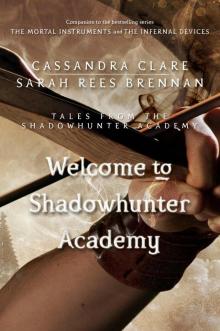 Welcome to Shadowhunter Academy (Tales from the Shadowhunter Academy Book 1)
Welcome to Shadowhunter Academy (Tales from the Shadowhunter Academy Book 1) Saving Raphael Santiago tbc-6
Saving Raphael Santiago tbc-6 City of Bones mi-1
City of Bones mi-1 Ghosts of the Shadow Market Book 1_Son of the Dawn
Ghosts of the Shadow Market Book 1_Son of the Dawn Clockwork Princess (Infernal Devices, The)
Clockwork Princess (Infernal Devices, The) Clockwork Prince tid-2
Clockwork Prince tid-2 No Immortal Can Keep a Secret
No Immortal Can Keep a Secret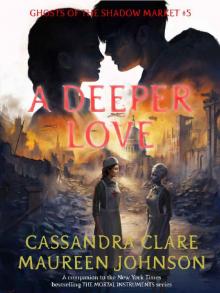 A Deeper Love (Ghosts of the Shadow Market Book 5)
A Deeper Love (Ghosts of the Shadow Market Book 5) The Course of True Love (and First Dates)
The Course of True Love (and First Dates)